Engine PONTIAC GRAND PRIX 1998 Owners Manual
[x] Cancel search | Manufacturer: PONTIAC, Model Year: 1998, Model line: GRAND PRIX, Model: PONTIAC GRAND PRIX 1998Pages: 402, PDF Size: 17.96 MB
Page 305 of 402

Radiator Pressure Cap
NOTICE:
Your radiator cap is a 15 psi (105 kPa)
pressure-type cap and must be tightly installed to prevent coolant loss and possible engine
damage from overheating. Be sure the arrows
on the cap line
up with the overflow tube on
the radiator filler neck.
When you replace your radiator pressure cap, a GM cap
is recommended.
Thermostat
Engine coolant temperature is controlled by a thermostat
in the engine coolant system. The thermostat stops the
flow of coolant through the radiator until the coolant
reaches a preset temperature.
When
you replace your thermostat, a GM thermostat
is recommended.
Power Steering Fluid
The power steering
fluid reservoir
is toward
3100 Engine
6-30
Page 306 of 402

3800 or 3800 Supercharged Engine
When to Check Power Steering Fluid
It is not necessary to regularly check power steering
fluid unless you suspect there is a leak in the system or
you hear an unusual noise.
A fluid loss in this system
could indicate
a problem. Have the system inspected
and repaired.
How To Check Power Steering Fluid
When the engine compartment is cool, wipe the cap and the top
of the reservoir clean, then unscrew the cap and
wipe the dipstick with a clean rag. Replace the cap and
completely tighten it. Then remove
the cap again and
look at the fluid level on the dipstick.
The level should be
at the “C” mark. If necessary, add
only enough fluid to bring the level up to the mark.
3800 or 3800 Supercharged Engine
6-31
Page 308 of 402
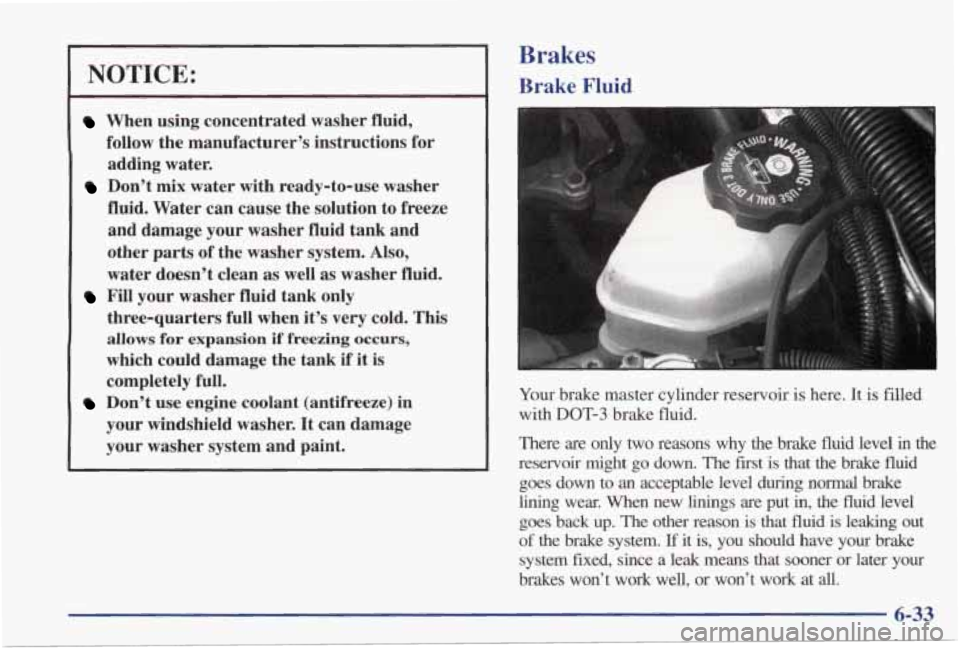
NOTICE:
When using concentrated washer fluid,
follow the manufacturer’s instructions for
adding water.
Don’t mix water with ready-to-use washer
fluid. Water can cause the solution to freeze
and damage your washer fluid tank and
other parts of the washer system. Also,
water doesn’t clean
as well as washer fluid.
three-quarters full when it’s very cold. This
allows for expansion if freezing occurs.
which could damage the tank if it is
completely full.
Don’t use engine coolant (antifreeze) in
your windshield washer. It can damage
your washer system and paint.
Fill your washer fluid tank only
Brakes
Brake Fluid
P
Your brake master cylinder reservoir is here. It is filled
with
DOT-3 brake fluid.
There are only
two reasons why the brake fluid level in the
reservoir might go down. The fxst is that the brake
fluid
goes down to an acceptable level during normal brake
lining wear. When new
linings are put in, the fluid level
goes back
up. The other reason is that fluid is leaking out
of the brake system. If it is, you should have your brake
system fwd, since a leak means that sooner or later your
brakes won’t work well, or won’t work
at all.
6-33
Page 309 of 402
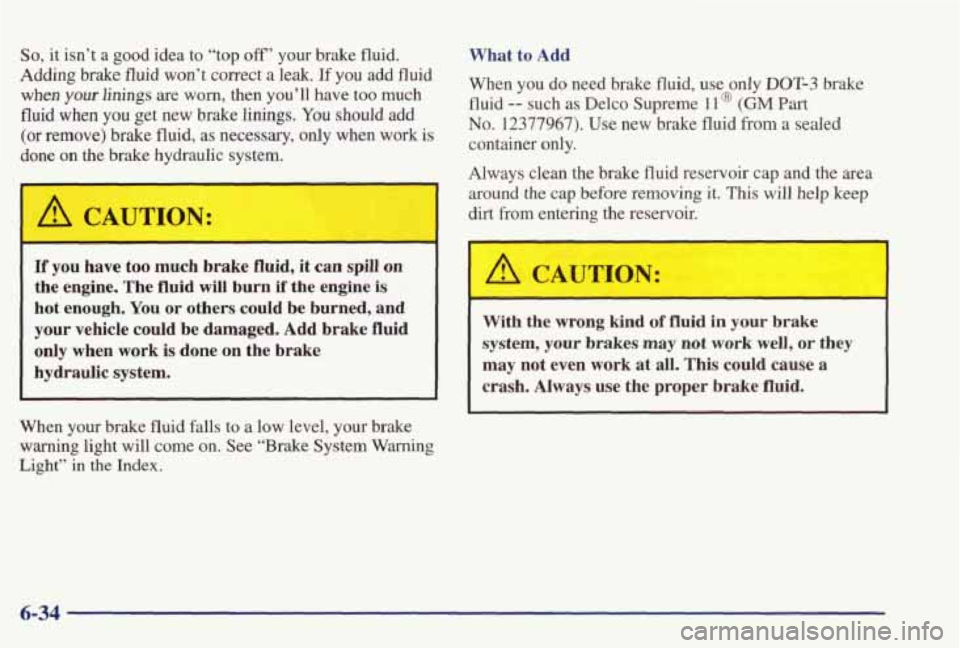
So, it isn’t a good idea to “top off’ your brake fluid.
Adding brake fluid
won’t correct a leak. If you add fluid
when your linings are worn, then you’ll have too much
fluid
when you get new brake linings. You should add
(or remove) brake fluid,
as necessary, only when work is
done
on the brake hydraulic system.
b -
A CAUTION:
If you have too much brake fluid, it can spill on
the engine. The
fluid will burn if the engine is
hot enough. You or others could be burned, and
your vehicle could be damaged. Add brake
fluid
only when work is done on the brake
hydraulic system.
When your brake fluid falls to
a low level, your brake
warning light will come
on. See “Brake System Warning
Light”
in the Index.
What to Add
When you do need brake fluid, use only
DOT-3 brake
fluid
-- such as Delco Supreme ll@ (GM Part
No. 12377967). Use new brake fluid from a sealed
container only.
Always clean the brake fluid reservoir cap and the area
around the cap before removing it. This will help keep
dirt from entering the reservoir.
I
A CAUTIOP’
With the wrong kind of fluid in your brake
system, your brakes may not work well, or they
may not even work
at all. This could cause a
crash. Always use the proper brake fluid.
6-34
Page 310 of 402
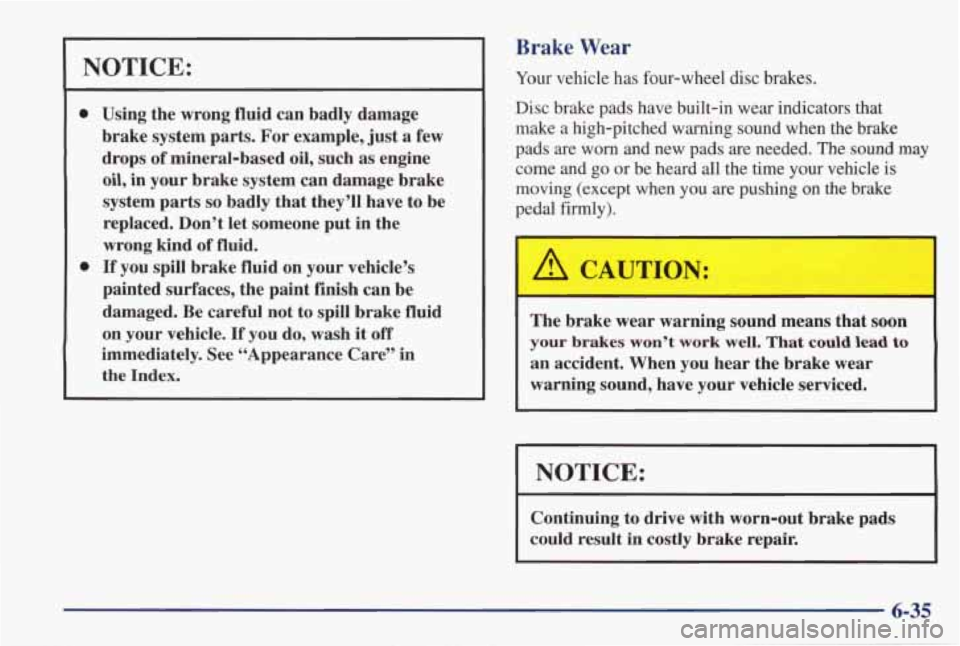
NOTICE:
0
0
Using the wrong fluid can badly damage
brake system parts. For example, just a few
drops
of mineral-based oil, such as engine
oil, in your brake system can damage brake
system parts
so badly that they’ll have to be
replaced. Don’t let someone put in the
wrong kind
of fluid.
If you spill brake fluid on your vehicle’s
painted surfaces, the paint finish can be
damaged. Be careful not to spill brake fluid
on your vehicle.
If you do, wash it off
immediately. See “Appearance Care’’ in
the Index.
Brake Wear
Your vehicle has four-wheel disc brakes.
Disc brake pads have built-in wear indicators that
make
a high-pitched warning sound when the brake
pads are worn and new pads are needed. The
sound may
come and go or be heard all the time your vehicle is
moving (except when you are pushing on the brake
pedal firmly).
The brake wear warning sound means that soon
your brakes won’t work well. That could lead to
an accident. When you hear the brake wear
warning sound, have your vehicle serviced.
I NOTICE:
Continuing to drive with worn-out brake pads
could result in costly brake repair.
6-35
Page 336 of 402

Vehicle Identification Number (VIN) Engine Identification
The 8th character in your VIN is the engine code. This
code will help
you identify your engine, specifications
and replacement parts.
Service Parts Identification Label
ENGINE/!& f ASSEMBLY You’ll find this label on the underside of your trunk lid. \
CODE MODEL YEAR PLANT It’s very helpful if you ever need to order parts. On this
label is:
This is the legal identifier for your vehicle. It appears on
a plate in the front corner of the instrument panel, on the
driver’s side. You can see it if you look through the
windshield from outside your vehicle. The VIN also
appears
on the Vehicle Certification and Service Parts
labels and the certificates of title and registration.
your VIN,
the model designation,
0 paint information and
a list of all production options and special
equipment.
Be sure that this label is not removed from the vehicle.
6-61
Page 340 of 402
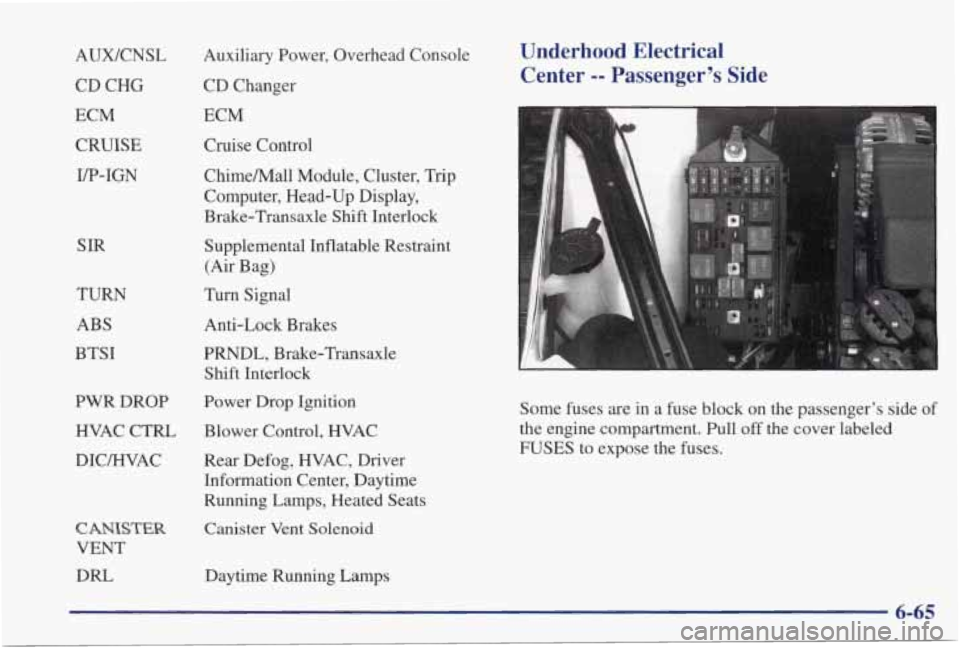
AUWCNSL CD CHG
ECM
CRUISE
UP-IGN
SIR
TURN
ABS
BTSI
PWR DROP HVAC CTRL
DIC/HVAC
DRL Auxiliary Power, Overhead Console
CD Changer
Underhood Electrical Center
-- Passenger’s Side
ECM
Cruise Control
ChimeNall Module, Cluster, Trip
Computer, Head-Up Display,
Brake-Transaxle Shift Interlock
Supplemental Inflatable Restraint
Turn Signal
(Air Bag)
Anti-Lock Brakes
PRNDL, Brake-Transaxle Shift Interlock
Power Drop Ignition
Blower Control, HVAC
Rear Defog, HVAC, Driver
Information Center, Daytime
Running Lamps, Heated Seats
Canister
Vent Solenoid
Daytime Running Lamps Some fuses are in a fuse block on the passenger’s side
of
the engine compartment. Pull
off the cover labeled
FUSES
to expose the fuses.
6-65
Page 343 of 402
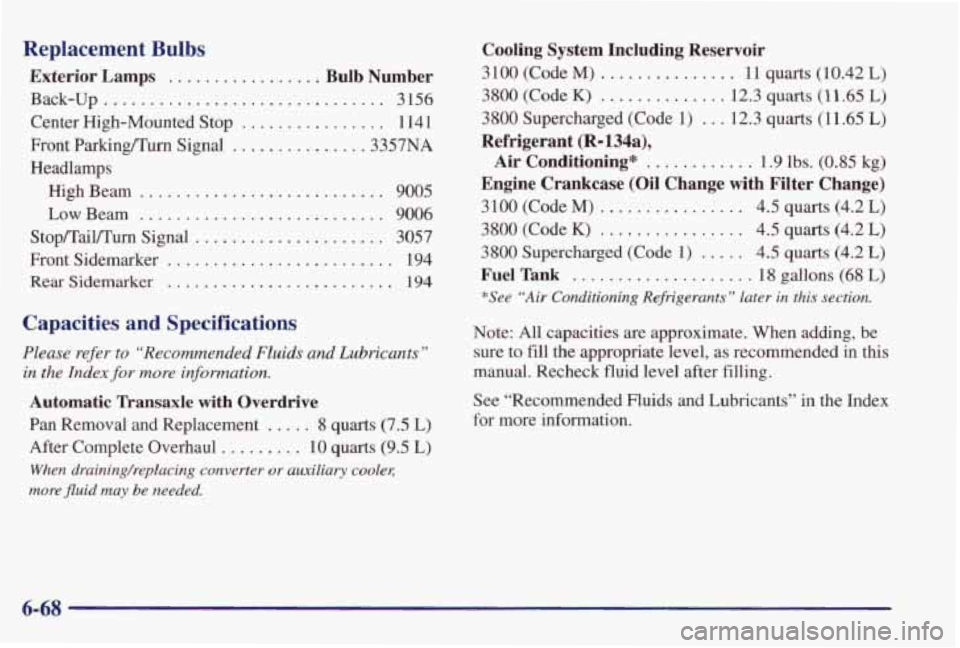
Replacement Bulbs
Exterior Lamps ............... Bulb Number
Back-up ............................... 3 156
Front Parking/Turn Signal
.............. .3357NA
Center High-Mounted Stop
................ 1141
Headlamps HighBeam
........................... 9005
Low Beam ........................... 9006
Front Sidemarker
......................... 194
Rear Sidemarker ......................... 194
Stop/Tail/Turn Signal ..................... 3057
Capacities and Specifications
Please refer to “Recommended Fluids and Lubricants”
in the Index for more information.
Automatic Transaxle with Overdrive
Pan Removal and Replacement ..... 8 quarts (7.5 L)
After Complete Overhaul ......... 10 quarts (9.5 L)
When drainingheplacing converter or auxiliary coolel;
more fluid
my be needed.
Cooling System Including Reservoir
3100 (CodeM) ............... 11 quarts (10.42 L)
3800 (Code K) .............. 12.3 quarts (11.65 L)
3800 Supercharged (Code 1) ... 12.3 quarts (11.65 L)
Refrigerant (R-l34a),
Engine Crankcase (Oil Change with Filter Change)
Air Conditioning*
............ 1.9 lbs. (0.85 kg)
3100 (Code M)
................ 4.5 quarts (4.2 L)
3800 (Code K) ................ 4.5 quarts (4.2 L)
Fuel Tank .................... 18 gallons (68 L)
3800 Supercharged (Code 1) ..... 4.5 quarts (4.2 L)
*See “Air Conditioning Refrigerants ” later in this section.
Note: All capacities are approximate. When adding, be
sure to fill the appropriate level, as recommended
in this
manual. Recheck fluid level after filling.
See “Recommended Fluids and Lubricants” in
the Index
for more information.
6-68
Page 344 of 402

3100 (Code M) Engine Specifications
Type .................................... V6
Displacement
....... . . 191 CID (3.1LL82)
Firing Order
...................... 1-2-3-4-5-6
Thermostat Temperature
........... 195 OF (9 1 O C)
Horsepower
................. ........ 160
3800 (Code K) Engine Specifications
Type .................................... V6
Displacement
............... 231 CID (3.8L L36)
Firing Order
...................... 1-6-5-4-3-2
Thermostat Temperature
........... 195 OF (9 1 O C)
Horsepower ............................. 195
3800 Supercharged (Code 1)
Engine Specifications
Type .................................. V6
Displacement
. . ......... 23 1 CID (3.8L L67)
Firing Order
.................... 1-6-5-4-3-2
Thermostat Temperature
. . ..... 195"F(9l0C)
Horsepower
......... ........... 240
Vehicle Dimensions
Wheelbase .............. 110.5 inches (280.7 cm)
Tread Width
................................
Front .................. 61.7 inches (156.8 cm)
Rear ................... 61.1 inches (155.2 cm)
Overall Length ........... 196.5 inches (499.1 cm)
Overall Height
............ 54.7 inches (1 39 cm)
Overall Width
.... ..... 72.7 inches (1 84.5 cm)
Page 345 of 402

Normal Maintenance
Replacement Parts
......... A1208C
Air Cleaner Filter
Battery
All Engines ..............
3100 (Code M) ......... ........ 600CCA
3800
(Code K) ...................... 690 CCA
3800 Supercharged (Code 1) ........... 770 CCA
All Engines ................. AC PF47
All Engines ...................... CV892C
Engine Oil Filter
PCV
Valve
Radiator Cap
All Engines ... .............. AC RC27
Spark Plugs
3100 (Code M) . . ......... AC Vpe 41-940
Gap: 0.060 inches (1.52 cm)
3800 (Code K) ................ AC Type 41-921
Gap: 0.060 inches (1.52 cm)
3800 Supercharged (Code 1) . . AC Qpe 41-921 or
NGK 5pe PTR4B- 15
Gap: 0.060 inches (1.52 cm)
Wiper Blades
vpe ................................. Hook
Length ................... .20 inches (50.8 cm) -
Air Conditioning Refrigerants
Not all air conditioning refrigerants are the same. If
the air conditioning system in your vehicle needs
refrigerant, be
sure the proper refrigerant is used. If
you’re not sure, ask your dealer.
6-70